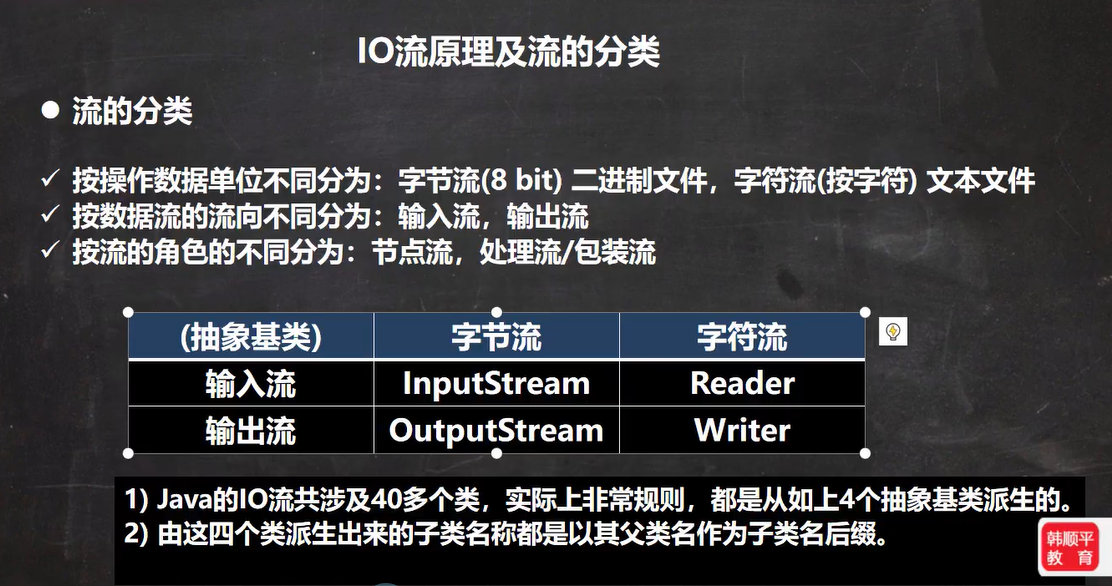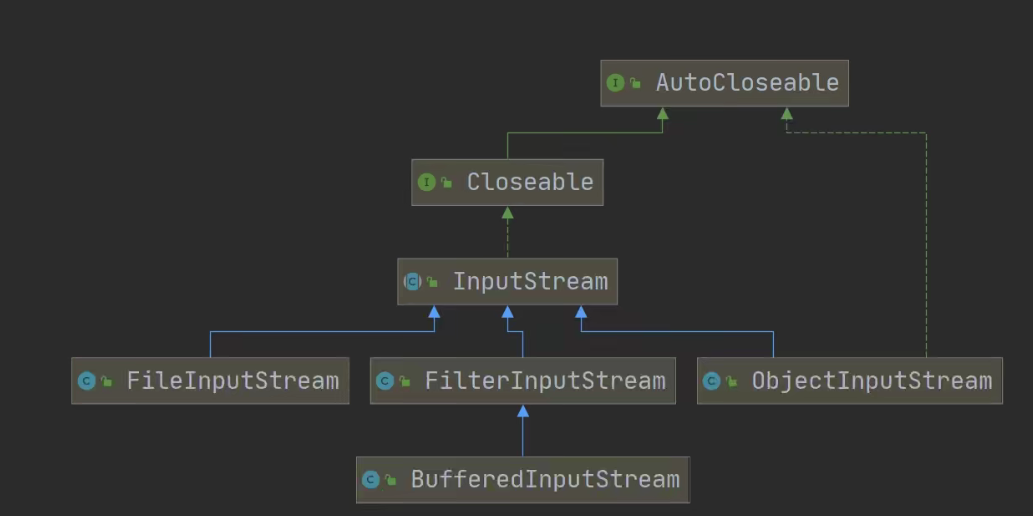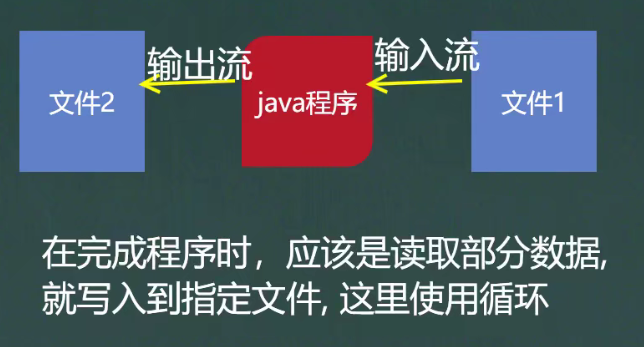文件
什么是文件
文件就是保存数据的地方
文件流
文件在程序中是以流的形式来操作的

流:数据在数据源(文件)和程序(内存)之间经历的路径
输入流:数据从数据源(文件)到程序(内存)的路径
输出流:数据从程序(内存)到数据源(文件)的路径、
常用的文件操作
创建文件的三种方式
方式1:
|
@Test
public void create01() {
String filePath = "D:\\Test\\IO\\news1.txt";
File file = new File(filePath);
try {
file.createNewFile();
System.out.println("文件创建成功!");
} catch (IOException e) {
e.printStackTrace();
System.err.println("创建出错了");
}
}
|
方式2:
|
@Test
public void create02() {
File parentFile = new File("D:\\Test\\IO\\");
String fileName = "news2.txt";
File file = new File(parentFile, fileName);
try {
file.createNewFile();
System.out.println("文件创建成功");
} catch (IOException e) {
e.printStackTrace();
}
}
|
方式3:
|
@Test
public void create03() {
String filePath = "D:\\Test\\IO\\";
String fileName = "news3.txt";
File file = new File(filePath, fileName);
try {
file.createNewFile();
System.out.println("创建成功");
} catch (IOException e) {
e.printStackTrace();
}
}
|
获取文件的相关信息
|
@Test
public void info() {
File file = new File("D:\\Test\\IO\\news1.txt");
System.out.println("文件名字:" + file.getName());
System.out.println("绝对路径:" + file.getAbsolutePath());
System.out.println("文件的父级目录" + file.getParent());
System.out.println("文件的大小(字节:" + file.length());
System.out.println("是否存在:" + file.exists());
System.out.println("是否是文件:" + file.isFile());
System.out.println("是否是文件夹:" + file.isDirectory());
}
|
目录的操作和文件删除
mkdir 创建一级目录,mkdirs 创建多级目录,delete 删除空目录或文件
1
2
3
4
5
6
7
8
9
10
11
12
13
14
15
16
17
18
19
20
21
22
23
24
25
26
27
28
29
30
31
32
33
34
35
36
37
38
39
40
41
42
43
44
45
46
|
@Test
public void m1() {
File file = new File("D:\\Test\\IO\\news1.txt");
if (file.exists()) {
if (file.delete()) {
System.out.println("删除成功!");
} else {
System.out.println("删除失败");
}
} else {
System.err.println("该文件不存在...");
}
}
@Test
public void m2() {
File file = new File("D:\\Test\\IO222");
if (file.exists()) {
if (file.delete()) {
System.out.println("删除成功");
} else {
System.out.println("删除失败");
}
} else {
System.out.println("该目录不存在...");
}
}
@Test
public void m3() {
File file = new File("D:\\Test\\a\\b");
if (!file.exists()) {
if (file.mkdirs()) {
System.out.println("创建成功");
} else {
System.out.println("创建失败");
}
} else {
System.out.println("该目录已存在...");
}
}
|
IO 流原理及流的分类
Java IO流原理
- I /O 是 Input / Output 的缩写,I/O技术是非常实用的技术,用于数据传输。如 读/写文件,网络通讯等。
- Java程序中,对于数据的输入/输出操作以
"流(stream)"的方式进行 - java.io 包下提供了各种”流”类和接口,用以获取不同种类的数据,并通过方法输入或输出数据
- 输入 input:读取外部数据(磁盘、光盘等存储设备的数据)到程序(内存)中
- 输出output:将承租(内存)数据输出到磁盘、光盘等存储设备中

IO流—常用的类
InputStream抽象类是所有类字节输入流的超类
InputStream 常用的子类
- FilelnputStream:文件输入流
- BufferedInputStream:缓冲字节输入流
- ObjectlnputStream:对象字节输入流

FilelnputStream 字节输入流
单个字节的读取:
1
2
3
4
5
6
7
8
9
10
11
12
13
14
15
16
17
18
19
20
21
22
23
24
|
@Test
public void readFile01() throws IOException {
String filePath = "D:\\Test\\hello.txt";
int readData = 0;
FileInputStream fileInputStream = null;
try {
fileInputStream = new FileInputStream(filePath);
while ((readData = fileInputStream.read()) != -1) {
System.out.print((char) readData);
}
} catch (IOException e) {
e.printStackTrace();
} finally {
fileInputStream.close();
}
}
|
字节数组方式
1
2
3
4
5
6
7
8
9
10
11
12
13
14
15
16
17
18
19
20
21
22
23
24
25
26
|
@Test
public void readFile02() throws IOException {
String filePath = "D:\\Test\\hello.txt";
byte[] buf = new byte[8];
int bufLen = 0;
FileInputStream fileInputStream = null;
try {
fileInputStream = new FileInputStream(filePath);
while ((bufLen = fileInputStream.read(buf)) != -1) {
System.out.print(new String(buf, 0, bufLen));
}
} catch (IOException e) {
e.printStackTrace();
} finally {
fileInputStream.close();
}
}
|
留空。。
FileOutputStream (字节输出流)
例子:
1
2
3
4
5
6
7
8
9
10
11
12
13
14
15
16
17
18
19
20
21
22
23
24
25
26
27
28
29
30
31
|
@Test
public void writeFile() throws IOException {
String filePath = "D:\\Test\\a.txt";
FileOutputStream fileOutputStream = null;
try {
fileOutputStream = new FileOutputStream(filePath, true);
String str = "hello,world";
fileOutputStream.write(str.getBytes(), 0, str.length());
} catch (IOException e) {
e.printStackTrace();
} finally {
fileOutputStream.close();
}
}
|
文件拷贝

代码实现:
1
2
3
4
5
6
7
8
9
10
11
12
13
14
15
16
17
18
19
20
21
22
23
24
25
26
27
28
29
30
31
32
33
|
@Test
public void copy01() throws IOException {
String srcfilePath = "D:\\Test\\login.jpg";
String dscfilePath = "D:\\Test\\IO\\login.jpg";
FileInputStream fileInputStream = null;
FileOutputStream fileOutputStream = null;
try {
fileInputStream = new FileInputStream(srcfilePath);
fileOutputStream = new FileOutputStream(dscfilePath);
byte[] buf = new byte[1024];
int readLen = 0;
while ((readLen = fileInputStream.read(buf)) != -1) {
fileOutputStream.write(buf, 0, readLen);
}
System.out.println("拷贝成功~");
} catch (IOException e) {
e.printStackTrace();
} finally {
if (fileInputStream != null)
fileInputStream.close();
if (fileOutputStream != null)
fileOutputStream.close();
}
}
|
FileReader (字符输入流)
单个字符读取
1
2
3
4
5
6
7
8
9
10
11
12
13
14
15
16
17
18
19
20
21
22
23
|
@Test
public void reader01() throws IOException {
String filePath = "D:\\Test\\a.txt";
FileReader fileReader = null;
int data = 0;
try {
fileReader = new FileReader(filePath);
while ((data = fileReader.read()) != -1) {
System.out.print((char) data);
}
} catch (IOException e) {
e.printStackTrace();
} finally {
if (fileReader != null)
fileReader.close();
}
}
|
使用字符数组读取
1
2
3
4
5
6
7
8
9
10
11
12
13
14
15
16
17
18
19
20
21
22
23
24
25
|
@Test
public void reader02() throws IOException {
String filePath = "D:\\Test\\a.txt";
FileReader fileReader = null;
int readLen = 0;
char[] buf = new char[10];
try {
fileReader = new FileReader(filePath);
while ((readLen = fileReader.read(buf)) != -1) {
System.out.print(new String(buf, 0, readLen));
}
} catch (IOException e) {
e.printStackTrace();
} finally {
if (fileReader != null)
fileReader.close();
}
}
|
FileWrite(字符输出流)
1
2
3
4
5
6
7
8
9
10
11
12
13
14
15
16
17
18
19
20
21
22
23
24
25
26
27
| @Test
public void write01() throws IOException {
String filePath = "D:\\Test\\b.txt";
FileWriter fileWriter = null;
try {
fileWriter = new FileWriter(filePath);
String str = "努力努力在努力!";
fileWriter.write(str);
} catch (IOException e) {
e.printStackTrace();
} finally {
if (fileWriter != null)
fileWriter.close();
}
System.out.println("执行成功...");
}
|
节点流和处理流
节点流 可以从一个特定的数据源读写数据,如 FileReader,FileWriter

处理流(也叫包装流)是 ==连接==在已存在的流(节点流或处理流)纸上,为程序提供更为强大的读写功能,如 BufferedReader、BufferedWriter

览图

节点流和处理流的区别和联系
1.节点流是底层流/低级流,直接跟数据源相接。
2.处理流(包装流)包装节点流,既可以消除不同节点流的实现差异,也可以提供更方便的方法
来完成输入输出。[源码理解]
3.处理流(也叫包装流)对节点流进行包装,使用了修饰器设计模式,不会直接与数据
源相连[模拟修饰器设计模式]
处理流的功能主要体现在以下两个方面:
性能的提高:主要以增加缓冲的方式来提高输入输出的效率。
操作的便捷:处理流可能提供了一系列便捷的方法来一次输入输出大批量的数据,使用更加灵活方便
BufferedReader
例子:
| @Test
public void read() throws Exception {
String path = "D:\\Test\\a.txt";
BufferedReader bufferedReader = new BufferedReader(new FileReader(path));
String readLine;
while ((readLine = bufferedReader.readLine()) != null) {
System.out.println(readLine);
}
bufferedReader.close();
}
|
BufferedWriter
例子:
1
2
3
4
5
6
7
8
9
10
11
12
13
14
15
16
17
| @Test
public void write() throws IOException {
String path = "D:\\Test\\aaaaa.txt";
BufferedWriter bufferedWriter = new BufferedWriter(new FileWriter(path));
bufferedWriter.write("hello,我是测试用的·····");
bufferedWriter.newLine();
bufferedWriter.write("H");
bufferedWriter.newLine();
bufferedWriter.write("我是字符数组写入".toCharArray());
bufferedWriter.newLine();
bufferedWriter.write("我是指定写入", 0, 6);
bufferedWriter.close();
System.out.println("运行完毕·····");
}
|
文件拷贝(字符流)
1
2
3
4
5
6
7
8
9
10
11
12
13
14
15
16
17
18
19
20
21
22
|
@Test
public void copy_() throws IOException {
String dirPath = "D:\\Test\\aaaaa.txt";
String newPath = "D:\\Test\\bbbbbb.txt";
BufferedReader bufferedReader = new BufferedReader(new FileReader(dirPath));
BufferedWriter bufferedWriter = new BufferedWriter(new FileWriter(newPath));
String line;
while ((line = bufferedReader.readLine()) != null) {
bufferedWriter.write(line);
bufferedWriter.newLine();
}
if (bufferedReader != null)
bufferedReader.close();
if (bufferedWriter != null)
bufferedWriter.close();
}
|
文件拷贝(字节流)
1
2
3
4
5
6
7
8
9
10
11
12
13
14
15
16
17
18
| @Test
public void copy() throws IOException {
String dirPath = "D:\\Test\\login.jpg";
String newPath = "D:\\Test\\test.jpg";
BufferedInputStream bufferedInputStream = new BufferedInputStream(new FileInputStream(dirPath));
BufferedOutputStream bufferedOutputStream = new BufferedOutputStream(new FileOutputStream(newPath));
byte[] bytes = new byte[1024];
int len = 0;
while ((len = bufferedInputStream.read(bytes)) != -1) {
bufferedOutputStream.write(bytes, 0, len);
}
System.out.println("运行结束····");
if (bufferedInputStream != null)
bufferedInputStream.close();
if (bufferedOutputStream != null)
bufferedOutputStream.close();
}
|
对象处理流
看一个需求
- 将 int num = 100 和这个int 数据保存到文件汇总,注意不是 100 数字,而是 int 100,并且,能够从文件中直接恢复 int 100
- 将 Dog dog = new Dog(“小黄”,3) 这个dog对象保存到文件中,并且能够从文件中恢复
上面的要求,就是能够基本数据类型或者对象进行序列化和反序列化操作
序列化和反序列化
- 序列化就是在保存数据时,保存数据的值和数据类型
- 反序列化就是在恢复数据时,恢复数据的值和数据类型
- 需要让某个对象支持序列化机制,则必须让其类时刻序列化的,为了让某个类时刻序列化的,该类必须实现以下两个接口之一:
Serializable 这是一个标记接口Externalizable
ObjectOutputStream 提供序列化功能
ObjectInputStream 提供反序列化功能
ObjectOutputStream (序列化)
1
2
3
4
5
6
7
8
9
10
11
12
13
14
15
16
17
18
19
20
|
@Test
public void write() throws IOException {
String filePath = "D:\\Test\\test.dat";
ObjectOutputStream outputStream = new ObjectOutputStream(new FileOutputStream(filePath));
outputStream.writeInt(100);
outputStream.writeBoolean(true);
outputStream.writeChar('J');
outputStream.writeDouble(2.33);
outputStream.writeUTF("哈哈哈哈");
outputStream.writeObject(new Dog("小黄", 3));
outputStream.close();
}
|
1
2
3
4
5
6
7
8
9
10
11
12
13
14
15
16
17
18
19
20
21
22
23
24
25
26
27
28
29
30
31
32
33
|
public class Dog implements Serializable {
private String name;
private Integer age;
public Dog(String name, Integer age) {
this.name = name;
this.age = age;
}
public String getName() {
return name;
}
public void setName(String name) {
this.name = name;
}
public Integer getAge() {
return age;
}
public void setAge(Integer age) {
this.age = age;
}
@Override
public String toString() {
return "Dog{" +
"name='" + name + '\'' +
", age=" + age +
'}';
}
|
1
2
3
4
5
6
7
8
9
10
11
12
13
14
15
16
17
| @Test
public void test() throws Exception {
String filePath = "D:\\Test\\test.dat";
ObjectInputStream inputStream = new ObjectInputStream(new FileInputStream(filePath));
System.out.println("int类型:" + inputStream.readInt());
System.out.println("boolean类型:" + inputStream.readBoolean());
System.out.println("char类型:" + inputStream.readChar());
System.out.println("double类型:" + inputStream.readDouble());
System.out.println("String类型:" + inputStream.readUTF());
Object object = inputStream.readObject();
Dog dog = (Dog) object;
System.out.println("dog对象:" + object);
System.out.println(dog.getName());
inputStream.close();
}
|
注意事项和细节
- 读写顺序要一致
- 要求实现序列化或反序列化对象,需要实现 Serializable
- 序列化的类中建议添加SerialVersionUID,为了提高版本的兼容性
- 序列化对象时,默认将里面所有属性都进行序列化,但余了staticgtransien修饰的成员
- 序列化对象时,要求里面属性的类型也需要实现序列化接口
- 序列化具备可继承性,也就是如果某类已经实现了序列化,则它的所有子类也已经默认实现了序列化
标准输入输出流
| 类型 | 默认设备 |
|---|
| System.in 标准输入 | InputStream | 键盘 |
| System.out 标准输出 | OutputStream | 显示器 |
代码解析:
1
2
3
4
5
6
7
8
9
10
11
12
13
14
15
16
17
| public class InputAndOutput {
public static void main(String[] args) {
System.out.println(System.in.getClass());
System.out.println(System.out.getClass());
}
}
|
转换流(可以设置编码)
介绍
- InputStreamReader:Reader的子类,可以将InputStream(字节流)包装成Reader(字符流)
- OutputStreamWriter:Writer的子类,实现将OutputStream(字节流)包装成Writer(字符流)
- 当处理纯文本数据时,如果使用字符流效率更高,并且可以有效解决中文问题,所以建议将字节流转换成字符流
- 可以在使用时指定编码格式(比如utf-8, gbk , gb2312, ISO8859-1等)
| @Test
public void read() throws IOException {
String filePath = "D:\\Test\\a.txt";
InputStreamReader inputStreamReader = new InputStreamReader(new FileInputStream(filePath), "GBK");
BufferedReader bufferedReader = new BufferedReader(inputStreamReader);
String data;
while ((data = bufferedReader.readLine()) != null) {
System.out.println(data);
}
bufferedReader.close();
}
|
OutputStreamWriter
| @Test
public void write() throws IOException {
String filePath = "D:\\Test\\ccc.txt";
FileOutputStream fileOutputStream = new FileOutputStream(filePath);
String charset = "utf8";
OutputStreamWriter osw = new OutputStreamWriter(fileOutputStream, charset);
BufferedWriter bufferedWriter = new BufferedWriter(osw);
bufferedWriter.write("哈哈哈");
bufferedWriter.close();
System.out.println("按照" + charset + "编码保存文件···");
}
|
打印流(只有输出流,没有输入流)
PrintStream(字节打印流)
代码
| @Test
public void printTest() throws IOException {
PrintStream out = new PrintStream(System.out);
out.println("哈哈哈哈哈");
out.write("哈哈哈2222".getBytes());
out.close();
System.setOut(new PrintStream("D:\\Test\\ces.txt"));
System.out.println("看看打印在哪···");
}
|
PrintWrite(字符打印流)
代码:
| @Test
public void printTest() throws IOException {
PrintStream out = new PrintStream(System.out);
out.println("哈哈哈哈哈");
out.write("哈哈哈2222".getBytes());
out.close();
System.setOut(new PrintStream("D:\\Test\\ces.txt"));
System.out.println("看看打印在哪···");
}
|
Properties配置文件
| ip=127.0.0.1
user=root
pwd=123456
|
传统方法取值
| @Test
public void read() throws IOException {
BufferedReader bufferedReader = new BufferedReader(new FileReader("src\\test.properties"));
String Line = "";
while ((Line = bufferedReader.readLine()) != null) {
String[] split = Line.split("=");
System.out.println(split[0] + "的值是:" + split[1]);
}
}
|
Properties类
专门用于读写配置文件的集合类
配置文件的格式:
键值
键=值
注意:键值对不需要有空格,值不需要用引号一起来。默认类型是String
- Properties的常见方法
- load:加载配置文件的键值对到Properties对象
- list:将数据显示到指定设备
- getProperty(key):根据键获取值
- setProperty(key,value):设置键值对到Properties对象
- store:将Properties中的键值对存储到配置文件,在idea中,保存信息到配置文件,如果含有中文,会存储为unicode码
使用Properties类
|
@Test
public void test() throws IOException {
Properties properties = new Properties();
properties.load(new FileReader("src\\test.properties"));
properties.list(System.out);
String user = properties.getProperty("user");
System.out.println("--------");
System.out.println(user);
}
|
创建或修改
|
@Test
public void test() throws IOException {
Properties properties = new Properties();
properties.setProperty("charset", "utf8");
properties.setProperty("username", "仅安c");
properties.setProperty("age", "22");
properties.store(new FileOutputStream("src\\test222.properties"), null);
System.out.println("保存配置文件成功···");
}
|
码云地址
https://gitee.com/only_ann/java-io-learning-test






